 |
Classic continental European not earthed plugs and sockets, part 1 |
round plugs |
 |
Classic continental European not earthed plugs and sockets, part 1 |
round plugs |
| Part 1 shows sockets and flat plugs (i.e.
having a rectangular base), made of
porcelain, steatite, ebonite, Bakelite or a comparable resin. Part 2
shows plugs with a
round base. Unless stated otherwise plugs have the following features in common: 1. Pin diameter of 4 mm and pin spacing of 19 mm. Pin length is 19 mm ± 0.5 mm 2. Rating, if indicated, of 6 Amp - 250 Volt. |
 |
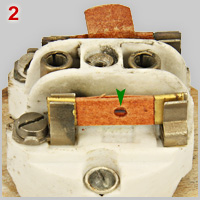 |
 |
 |
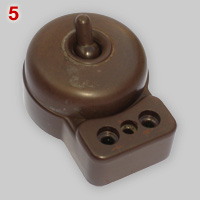 |
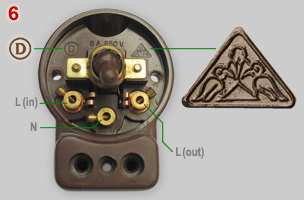 |
| 1, 2 |
Surface
mount, white glazed steatite socket, rated at 10A-250V. Both poles are
fused (see green arrow). Fuses existed at least for 2A, 6A and 10A. The
advantage of a fused socket that in case of short circuit the
consequence are limited to not working appliance(s) connected to the
socket, rather than a power failure that concerns the whole house. It
was possible - but risky - to replace these simple fuses without
switching off electricity. As an alternative to fused socket, separate porcelain or steatite fuse boxes were used (see page on classic French material). Dating: 1910s. {RH} |
| 3 | Flush mount socket of unknown origin. The wall plate is made of non-translucent white glass. Designs with clear glass existed too. They allowed a nearly uninterrupted look at wallpaper. Glass sockets were typically a luxurious product. Rating is not indicated, but it has two fuses (comparable to image no. 2), each rated a 10A. Dating: 1930s, but glass wall plates were already produced in the 1910s. {RH} |
| 4 | Flush mount socket, rated at 10A-250V, assembled and sold by Stotz-Kontakt, Fabrik elektrotechnische Spezialartikel in Mannheim. The Bakelite wall plate has been produced by Preßstoffwerke H. Römmler in Spremberg (Sachsen), while the steatite body was made by Steatit-Magnesia in Teltow bei Berlin. Probably late 1930s. {RH} |
| 5, 5a |
Combined
Bakelite single pole light switch and not earthed socket, rated at
6A-250V. It was
efficient to combine socket
and light switch if a
room had a single light source and no more than one socket. It has a
remarkable
logo, showing birds (parrots?). The only other mark is a Danish
certification mark (encircled D), which may indicate that the socket
has been made by an, unknown, manufacturer in Denmark. A French 1936-37
catalog of Croissandeau (wholesaler in Orleans) shows
a very similar "combinaison"
(combination of switch and socket for domestic use), but without a link
to its origin. {YG} |
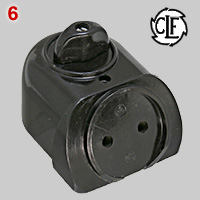 |
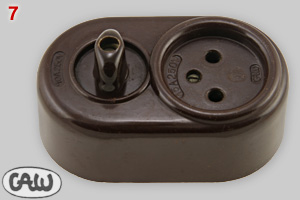 |
| 6 | 10A-250V socket with integrated switch, Both
porcelain body, switch and Bakelite cast carry the Carl Friedrich
Lübold logo. Dating: 1930s (see list of German manufacturers for details). {MN} |
| 7 | Socket and single pole light switch. Socket is rated at 15A-250V, whereas the switch is rated at 10A. Both porcelain body and Bakelite cast carry the CAW logo, used by Casp. Arn. Winkhaus in Carthausen (Westfalen), but the cast itself has been made by Ernst Bremicker in Kierspe (Westfalen), given the MAPD code 61-S (see MPAD page for details). Dating: 1930s. {WN} |
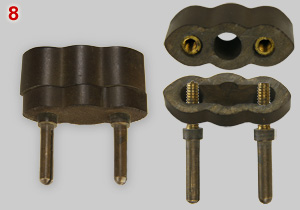 |
 |
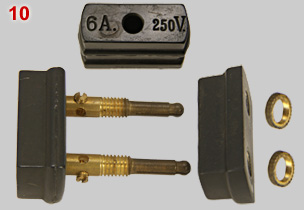 |
 |
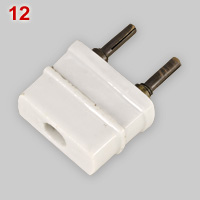 |
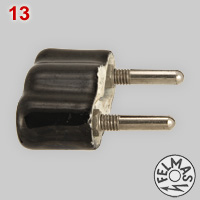 |
 |
| 8 | Basic
type of plug, made of ebonite. No rating, or indication of
manufacturer. Probably German made in 1900s - 1910s.
{WN} |
| 9, 10 | An
example of a very popular type of plug made in Germany in the
1900s-1930s. Comparable models made of timber have been made before
1900. See also steatite plug nos. 11 and 12. Rating:
6A-250V; no other marks or indication of manufacturer. To connect wires two ring shaped nuts have to be unscrewed. Nuts are exposed, rather than being hidden in a recess (compare with plug nos. 16, 17 and 20). Only in connectors as no, 14, with recessed contacts, the full length of pins can be inserted to eliminate the risk of touching parts under tension. |
| 11, 12 |
Black
and
white glazed steatite plugs that are essentially identical to ebonite
plug no. 9/10. The ball shaped ends of pins of nos. 9 and 11
point to an early - 1900s- '10s - model. Dating of plug no. 12: 1920s -
'30s. No rating, no name.
{RH} |
| 13 | Black
glazed steatite plug with partially recessed nuts to fix wires. The
design resembles plug no. 8. Dating 1920s. Plug has been made by Gustav Schortmann & Sohn, Fabrik elektrotechnischer Spezial-artikel in Leipzig, who used the trademark FELMAS. The company was in the 1930s one of the German market leaders for plugs and appliance connectors, but after WW II the company badly hit by Soviet Union reparations. There have been made Felmas installation materials, but the successful prewar years were definitely over. {RH} |
| 14 | Ebonite
connector that matches with plug no. 9/10. Probably German made in the
1910s-'20s.
{WN} |
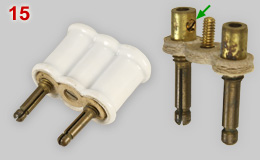 |
 |
 |
 |
 |
 |
| 15 | Basic, porcelain plug. Compared to plug no.13 it has an improved system of wire connection. Manufacturer is unknown. Dating: late 1910s. {RH} |
| 16 |
White
glazed steatite
plug with
an alternative method of wiring, made by Thega-Kontakt in Berlin*. It
has a patented system by insering wires through the a hole in the round
nuts before screwing down. The drawback of the system is that copper
wires will be hardly secured and may tear apart. Dating: late 1920s -
early 1930s. {RH} * A list of Jewish businesses in Berlin shows that Thega-Kontakt was founded in 1923 and confiscated in 1938. Post-War electrotechnical products of Thega-Kontakt are unknown. |
| 17 | Bakelite
plug and matching connector, made by Heinrich Kopp, Spezialfabrik
elektrotechnischer Artikel in Sonneberg (Thüringen). The company was
founded in 1927. After WW II large parts of the company were claimed by the Soviet Union for reparations;
Heinrich Kopp started again in Oberfranken (northeast Bavaria). From
1956 electro-technical parts are
produced in Kahl am Main. Shown
plug and connector date back to
1930s.
{WN} |
| 18 | Porcelain
plug made by Siemens-Schuckertwerke in Berlin. Brass nuts, connected to
pin extensions are used to assemble both parts of the plug. Because
nuts are directly connected to the pins, they are under tension when
the plug is connected to mains.
Siemens plug no. 10 (next page) shows
an improved model. Dating: late 1910s - early 1920s.
{FS} |
| 19 | Ebonite
connector with an unusual large grip.
Connector no. 2005 is shown in a 1932 catalog of the Dutch company
Inventum shows that the large grip offers the possibility to relief
cord tension by wrapping around cords.
{WN} |
| 20 | Simple
Bakelite* model that was a popular model in France, Belgium and
Switzerland in the 1930s. No name or marks. {WN} * A 1934 catalog shows a similar plug, made of Excellithe, a trademark for Bakelite used by Vynckier Frères & Co. (Ghent, Belgium). |
 |
 |
 |
 |
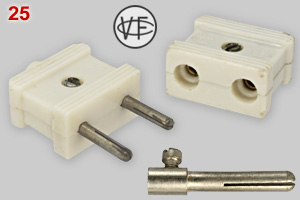 |
 |
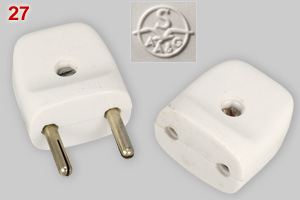 |
| note |
Plug
and connectors nos. 21 - 27 are successors of the ebonite plug no. 9
and connector no. 14. The original transversely divided housing is
replaced by longitudinally division. From 1990 Europlugs
(CEE 7/16) became the standard flat plug with 4.0 mm pins for lower
power devices that do not need earthing. |
| 21, 22 |
Bakelite
plug and connector that were commonly used in the 1930s and 1940s. The
rating of shown specimen is inconsistent: the plug is rated 10A versus
15A for the connector. Similar types are rated at a more usual 6A. Plug
and connector have good quality pins and contacts. A previous owner of
the connector created an original alternative to a cord grip. Manufacturers: FENO, a yet unknown company*. * the LED illumimation coimpany feno GmbH in München-Oberhaching (Munich, Germany), was founded in 1998. |
| 23, 24 |
Plug and connector produced in the 1950s. Due to a shortage of materials, shortly after WW II, pins were made of folded metal sheets rather than using solid pins. Plug and connector have been made by Franz Stauch in Unterrodach (Oberfranken region of Bavaria). |
| 25 |
Plug
and
connector that can be regarded as successors of nos. 23 and 24.
The plug has solid, partially split pins. The VFC logo stands for Vynckier Frères & Co., a Belgian company established in 1937 in Gent. General Electric (US) acquired Vynckier in 1995; the company still makes plugs, sokets and other electro-technical accessories. |
| 26 | Low cost
plug and connector commonly used in the Netherlands in the 1970s. The
safety
standard of these types was
limited because the plastic housing was quite breakable. The
manufacturers name was never shown. |
| 27 | The
solidity of this Italian design was much better than previous
plug and connector. Dating: second
half of 1970s -
mid 1980s. The AA&G S logo
stands for Italian
company
Aristide, Arturo e Giuseppe Stucchi (founded in 1944 as Electra in
Lecco (Lombardia, Italy); in
1950 renamed to A A & G Stucchi). Today the company is globally
active in developing products for lighting. |
 |
 |
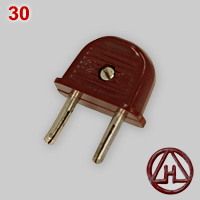 |
 |
| 28 | Wooden
plug (beech?), once painted black. Very early, late 19th century plugs
have been made of wood. In the 1920s - '30s, when steatite and Bakelite
were commonly used, wooden plugs almost disappeared. At the end of
World
War II, when resources were scarce, there has been a short lasting
revival of wooden plugs. Dating
of the shown plug is uncertain. It could be an early 20th plug, because
it has brass pins of good quality. Brass pins
almost certainly exclude that it is a mid 1940s plug. {RH} |
| 29 | Plug
made of vulcanized fibre, a laminated material composed pressed layers
cotton rag sheets. The inset shows the typical look of vulcanized
fibre, which is 100% cellulose. Vulcan fibre has high tear and tensile
strength and a high insulating value. A sizable number of layers
offers the possibility to make very stable blocks that can be
processed. Dating: possibly 1930s - '40s. {RH} |
| 30 | A
small, basic plug rated at 6A-260V, made of red melamine
resin. Manufacturer: Heinrich Wiedersprecher in Erndtebrück, Westfalen,
Germany. Dating: probably 1970s. {WN} |
| 31 | An
unusual, quite minimalistic plug with short pins. Wieger Nieuwenhout
has informed me that such plugs have been made in a variety of colours
and designs. They have been made of galalithe, a plastic that could
made
in any colour and were rated at 3A. It was quite popular in France and
Belgium. It is
unknown for which type of application these small
plugs have been made.
{WN} 21st century 'retro-style', Italian galatithe plugs are shown on the CEI 23-50 page. |
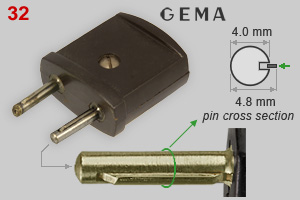 |
 |
 |
| 32 | Flat,
two-pin plug, rated at 6A - 250V. Pins have a diameter of 4.0 mm and a
raised metal strip; see enlarged image of a pin and cross section. The
strip is flexible and can be fully
pushed in. It assures stable contact with inflexible tube-type socket
contacts
that were used in some older sockets. The plug has no mark that can give a clue about the country of origin. The abbreviation GEMA may refer to the German company Gesellschaft für Elektroakustische und Mechanische Apparate. See list of German manufacturers for details. Indication of dating: the German company existed from 1934 until 1945. |
| 33, 34 |
Ebonite two-pin plug without any marks or
texts. Pin spacing: 19 mm. Partly split pins have a length of 18.5 mm. Rating, manufacturer and dating are unknown. The reason to show the plug is the adaptable pin diameter. Pin ends - in the plug housing - have a shaft. A 35 mm long needle, with 1.7 mm diameter (see image 33), can be screwed into shaft. Initially pin diameter remains unchanged: 4.0 mm; see upper pin in image 34. Screwing in the needle another 2 mm widens pin tip diameter to 4.7 mm; see lower pin in image 34. There are two reasons why an adaptable pin diameter can be useful: (1) to ensure physical touching a socket contact that has a diameter more than 4.0 mm, and (2) firmly locking the plug in a socket with 4.0 to ca. 4.5 mm contacts. An essentially comparable locking mechanism is used in a modern locking Schuko plug, designed by Kalthoff GmbH, see images 11-14 on uncommon Schuko page. |
| |
D i g i t a l M u s e u m o f | |
P l u g s a n d S o c k e t s | part 2 |